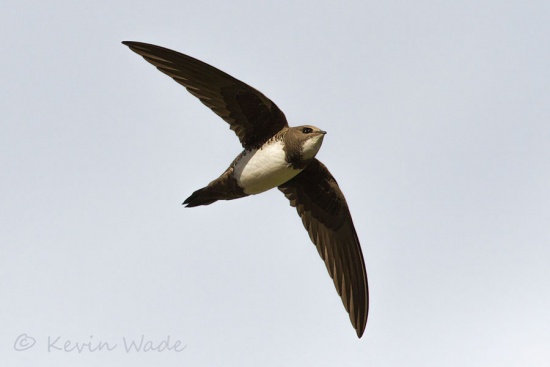- Tachymarptis melba
Apus melba
Identification
Ws. 55cm
- Very short legs
- Large
- All black with white belly and throat
- Dark neck band separates the white areas
- Short forked tail
- Very long swept-back wings that resemble a crescent
Similar Species
Noticeably larger than Common Swift, with slower more languid and deliberate wingbeats.
Distribution
Widespread and fairly common around the Mediterranean. Breeds in much of Spain, particularly the north and east, the Balearics and parts of coastal Portugal, southern France and the Alps, Corsica, Sardinia, Sicily and much of Italy. Also found through much of the western Balkans but patchily in the east, on Crete, many other Greek islands and Cyprus. Widespread in Turkey, the Caucasus and Crimea and breeds locally in the Middle East and in at scattered sites across North-West Africa.
Beyond Western Palearctic range extends across southern Asia from Arabia to the Himalayas, India and Sri Lanka, and also occurs in eastern and southern Africa and Madagascar.
Migratory, leaving breeding areas September-early October and wintering in sub-Saharan Africa and India. Return movement is mainly in April.
Annually recorded north to British Isles (c.480 records), mainly on east and south coasts in March-November with peaks in May-June and September-October. Vagrants also recorded in Iceland and Scandinavia and most northern European countries, west to Madeira and east to Iraq.
Taxonomy
Subspecies
Eight subspecies are recognised.
- Nominate melba occurs over European range, northern Morocco and east to the Himalayas, in the south of Morocco and throughout remainder of North Africa to South-West Asia it is replaced by the paler and greyer tuneti but intermediates occur over large areas.
- archeri is found in Somalia
- maximus on Mt Ruwenzori
- africanus in much of eastern and southern Africa
- marjoriae in Namibia
- willsi in Madagascar
- bakeri in southern India and Sri Lanka
Habitat
Occurs in mountains, sea-cliffs and inland gorges, also urban areas. Breeds on tall buildings and crevices in cliff faces, feeds over virtually any kind of country.
Behaviour
Gregarious, often associating with Common Swifts.
Breeding
Build their nests in colonies in a suitable cliff hole or cave, laying 2-3 eggs. A swift will return to the same site year after year, rebuilding its nest when necessary. These birds pair for life.
Young swifts in the nest can drop their body temperature and become torpid if bad weather prevents their parents from catching insects nearby.
Diet
Alpine Swifts spend most of their lives in the air, living on the insects they catch in their beaks. They drink on the wing, but roost on vertical cliffs or walls.
Vocalisation
A high-pitched trill.
References
- Collins Field Guide 5th Edition
- Collins Bird Guide ISBN 0 00 219728 6
External Links
GSearch checked for 2020 platform.1




